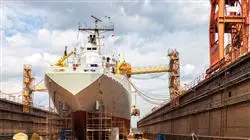University certificate
The world's largest faculty of engineering”
Introduction to the Program
Naval Engineering is a constantly evolving sector that requires qualified professionals trained in the use of the latest tools in the field”

The Postgraduate diploma in Basic Naval Engineering is a program of the highest academic level that aims to educate professionals in the field, enabling them to carry out their work with the highest quality and safety requirements. It is a very complete program, imparted by professionals with years of experience, and which includes the latest advances in the field.
Specifically, the program covers structural, outfitting and electrical Basic Naval Engineering as a basis for Detailed Engineering, including the necessary requirements for documentation and mandatory calculations to obtain approval from shipowners, classification societies and the flag authority. Another important aspect of detail Engineering, which will contribute to professional specialization, is learning how to use 3D modeling tools and innovative virtual reality methodologies.
Likewise, this Postgraduate diploma will give students the keys to perform the conceptual design for vessels, which aims to provide a higher level of detail, especially identifying and defining those features that have a significant effect on other features of the vessel, including cost. Structural design principles will also be explained, including construction systems and materials used. The minimum parameters for each are detailed depending on the structural system, as well as its different elements, without forgetting the importance of welding and its calculation methodology.
Finally, the Postgraduate diploma focuses on Basic Naval Engineering of installations, machinery and electricity in naval vessel or craft projects. This section is of vital importance to any project, both for professionals in naval engineering of armament and machinery, as they will update their knowledge of this, and for anyone working in any sector in the industry, as knowledge of the core of the facilities on board will be covered, all of which will qualify professionals and strengthen their profiles for this particular niche in the field.
It should be noted that, as this is a 100% online Postgraduate diploma, students are not constrained by fixed schedules or commutes, but can access the contents at any time of the day, balancing their work or personal life with their academic life.
The completion of this Postgraduate diploma will place Naval Engineering professionals at the forefront of the latest developments in the sector”
This Postgraduate diploma in Basic Naval Engineering contains the most complete and up-to-date program on the market. The most important features include:
- Case studies presented by experts in Naval Engineering
- The graphic, schematic, and practical contents with which they are created, provide scientific and practical information on the disciplines that are essential for professional practice
- Practical exercises where the self-assessment process can be carried out to improve learning
- Special emphasis on innovative methodologies in Naval Engineering
- Theoretical lessons, questions to the expert, debate forums on controversial topics, and individual reflection assignments
- Content that is accessible from any fixed or portable device with an Internet connection
This Postgraduate diploma is the best investment you can make in selecting a refresher program in the field of Naval Engineering. We offer you quality and free access to content"
The teaching staff includes professionals in Basic Naval Engineering, who bring their experience to this program, as well as renowned specialists from leading societies and prestigious universities.
The multimedia content, developed with the latest educational technology, will provide the professional with situated and contextual learning, i.e., a simulated environment that will provide immersive training programmed to train in real situations.
This program is designed around Problem-Based Learning, whereby the professional must try to solve the different professional practice situations that arise throughout the program. For that purpose, students will be assisted by an innovative, interactive video system developed by renowned and extensively experienced experts in Basic Naval Engineering.
This training program comes with the best learning material, providing you with a contextual approach that will facilitate your learning"

This 100% online Postgraduate diploma will allow you to combine your studies with your professional work. You choose where and when to train"
Why study at TECH?
TECH is the world’s largest online university. With an impressive catalog of more than 14,000 university programs available in 11 languages, it is positioned as a leader in employability, with a 99% job placement rate. In addition, it relies on an enormous faculty of more than 6,000 professors of the highest international renown.

Study at the world's largest online university and guarantee your professional success. The future starts at TECH”
The world’s best online university according to FORBES
The prestigious Forbes magazine, specialized in business and finance, has highlighted TECH as “the world's best online university” This is what they have recently stated in an article in their digital edition in which they echo the success story of this institution, “thanks to the academic offer it provides, the selection of its teaching staff, and an innovative learning method aimed at educating the professionals of the future”
A revolutionary study method, a cutting-edge faculty and a practical focus: the key to TECH's success.
The most complete study plans on the university scene
TECH offers the most complete study plans on the university scene, with syllabuses that cover fundamental concepts and, at the same time, the main scientific advances in their specific scientific areas. In addition, these programs are continuously being updated to guarantee students the academic vanguard and the most in-demand professional skills. In this way, the university's qualifications provide its graduates with a significant advantage to propel their careers to success.
TECH offers the most comprehensive and intensive study plans on the current university scene.
A world-class teaching staff
TECH's teaching staff is made up of more than 6,000 professors with the highest international recognition. Professors, researchers and top executives of multinational companies, including Isaiah Covington, performance coach of the Boston Celtics; Magda Romanska, principal investigator at Harvard MetaLAB; Ignacio Wistumba, chairman of the department of translational molecular pathology at MD Anderson Cancer Center; and D.W. Pine, creative director of TIME magazine, among others.
Internationally renowned experts, specialized in different branches of Health, Technology, Communication and Business, form part of the TECH faculty.
A unique learning method
TECH is the first university to use Relearning in all its programs. It is the best online learning methodology, accredited with international teaching quality certifications, provided by prestigious educational agencies. In addition, this disruptive educational model is complemented with the “Case Method”, thereby setting up a unique online teaching strategy. Innovative teaching resources are also implemented, including detailed videos, infographics and interactive summaries.
TECH combines Relearning and the Case Method in all its university programs to guarantee excellent theoretical and practical learning, studying whenever and wherever you want.
The world's largest online university
TECH is the world’s largest online university. We are the largest educational institution, with the best and widest online educational catalog, one hundred percent online and covering the vast majority of areas of knowledge. We offer a large selection of our own degrees and accredited online undergraduate and postgraduate degrees. In total, more than 14,000 university degrees, in eleven different languages, make us the largest educational largest in the world.
TECH has the world's most extensive catalog of academic and official programs, available in more than 11 languages.
Google Premier Partner
The American technology giant has awarded TECH the Google Google Premier Partner badge. This award, which is only available to 3% of the world's companies, highlights the efficient, flexible and tailored experience that this university provides to students. The recognition as a Google Premier Partner not only accredits the maximum rigor, performance and investment in TECH's digital infrastructures, but also places this university as one of the world's leading technology companies.
Google has positioned TECH in the top 3% of the world's most important technology companies by awarding it its Google Premier Partner badge.
The official online university of the NBA
TECH is the official online university of the NBA. Thanks to our agreement with the biggest league in basketball, we offer our students exclusive university programs, as well as a wide variety of educational resources focused on the business of the league and other areas of the sports industry. Each program is made up of a uniquely designed syllabus and features exceptional guest hosts: professionals with a distinguished sports background who will offer their expertise on the most relevant topics.
TECH has been selected by the NBA, the world's top basketball league, as its official online university.
The top-rated university by its students
Students have positioned TECH as the world's top-rated university on the main review websites, with a highest rating of 4.9 out of 5, obtained from more than 1,000 reviews. These results consolidate TECH as the benchmark university institution at an international level, reflecting the excellence and positive impact of its educational model.” reflecting the excellence and positive impact of its educational model.”
TECH is the world’s top-rated university by its students.
Leaders in employability
TECH has managed to become the leading university in employability. 99% of its students obtain jobs in the academic field they have studied, within one year of completing any of the university's programs. A similar number achieve immediate career enhancement. All this thanks to a study methodology that bases its effectiveness on the acquisition of practical skills, which are absolutely necessary for professional development.
99% of TECH graduates find a job within a year of completing their studies.
Postgraduate Diploma in Basic Naval Engineering
.
Discover the power of becoming a Postgraduate Diploma in Basic Naval Engineering through our virtual modality at TECH Global University! Are you ready to develop skills that will open the doors to a bright future? Our team of highly qualified faculty will guide you along this exciting journey. With their extensive experience and technical knowledge, you'll be in good hands as you delve into key topics such as ship design, marine propulsion, control systems and many other fundamental areas. Get ready to acquire advanced technical skills and hone your ability to solve complex problems in the marine field. You'll explore the fundamental principles of ship design, learning about engines and power systems used in navigation, as well as the latest sustainable technologies and practices. You'll also explore the control and automation systems present in modern vessels, understanding their importance in ensuring optimal performance.
You'll also explore the control and automation systems present in modern vessels, understanding their importance in ensuring optimal performance.
Enroll today and get ready to transform your future!
.
At TECH, we are proud to offer you the opportunity to study at our prestigious institution. Our commitment to academic excellence and quality teaching is reflected in each of our programs. In addition, our virtual mode gives you the flexibility to adapt your studies to your own pace, without compromising the quality of your education. Imagine holding in your hands a certificate that supports your mastery of the essential fundamentals of marine engineering. Upon completion of this program, you will be recognized as an expert in this vitally important area. Would you like the opportunity to be among the elite in the field of marine engineering? Upon completion of this program, you will find yourself in a prime position to forge an exciting and rewarding career. You will be able to work in shipyards, shipping companies, consulting firms and many other related industries. Don't miss this incredible opportunity to become a Postgraduate Diploma in Basic Naval Engineering. Take advantage of the convenience of our virtual modality, the backing of a recognized certificate and the support of our outstanding teachers.







